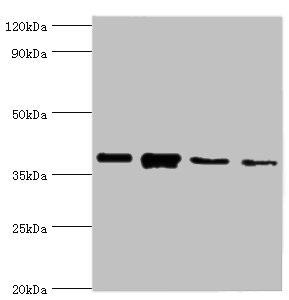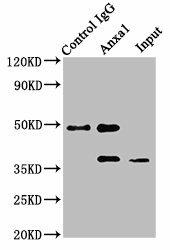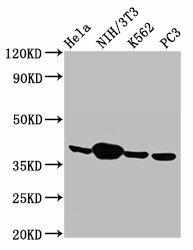Description
| Antibody Name: | Anxa1 Antibody (PACO24920) |
| Antibody SKU: | PACO24920 |
| Size: | 50ug |
| Host Species: | Rabbit |
| Tested Applications: | ELISA, WB, IP |
| Recommended Dilutions: | ELISA:1:2000-1:10000, WB:1:1000-1:5000, IP:1:200-1:2000 |
| Species Reactivity: | Human, Mouse |
| Immunogen: | Recombinant Mouse Annexin A1 protein (2-346AA) |
| Form: | Liquid |
| Storage Buffer: | Preservative: 0.03% Proclin 300 Constituents: 50% Glycerol, 0.01M PBS, PH 7.4 |
| Purification Method: | >95%, Protein G purified |
| Clonality: | Polyclonal |
| Isotype: | IgG |
| Conjugate: | Non-conjugated |
 | Western blot All lanes: Anxa1 antibody at 2µg/ml Lane 1: PC-3 whole cell lysate Lane 2: A431 whole cell lysate Lane 3: K562 whole cell lysate Lane 4: MCF-7 whole cell lysate Secondary Goat polyclonal to rabbit IgG at 1/10000 dilution Predicted band size: 39 kDa Observed band size: 39 kDa . |
 | Immunoprecipitating Anxa1 in NIH/3T3 whole cell lysate Lane 1: Rabbit control IgG instead of PACO24920 in NIH/3T3 whole cell lysate.For western blotting, a HRP-conjugated Protein G antibody was used as the secondary antibody (1/2000) Lane 2: PACO24920 (8µg) + NIH/3T3 whole cell lysate (500µg) Lane 3: NIH/3T3 whole cell lysate (20µg) . |
 | Western Blot Positive WB detected in: Hela whole cell lysate, NIH/3T3 whole cell lysate, K562 whole cell lysate, PC-3 whole cell lysate All lanes: Anxa1 antibody at 2.9µg/ml Secondary Goat polyclonal to rabbit IgG at 1/50000 dilution Predicted band size: 39 kDa Observed band size: 39 kDa . |
| Background: | Calcium/phospholipid-binding protein which promotes membrane fusion and is involved in exocytosis. This protein regulates phospholipase A2 activity. It seems to bind from two to four calcium ions with high affinity. |
| Synonyms: | Annexin A1 (Annexin I) (Annexin-1) (Calpactin II) (Calpactin-2) (Chromobindin-9) (Lipocortin I) (Phospholipase A2 inhibitory protein) (p35), Anxa1, Anx1 Lpc-1 Lpc1 |
| UniProt Protein Function: | ANXA1: a calcium/phospholipid-binding protein with which promotes membrane fusion and is involved in endocytosis. Has anti-inflammatory properties and inhibits phospholipase A2 activity. Accumulates on internalized vesicles after EGF-stimulated endocytosis, suggesting that it may be required for a late stage in inward vesiculation. Phosphorylated by PKC, EGFR and Chak1. Phosphorylation results in loss of the inhibitory activity. Annexins are a family of structurally related proteins whose common property is calcium-dependent binding to phospholipids. There are at least ten different annexins in mammalian species. Annexins do not contain signal peptides, yet some annexins (A1, A2 and A5) appear to be secreted in a physiologically regulated fashion.Protein type: Lipid-binding; Calcium-bindingChromosomal Location of Human Ortholog: 9q21.13Cellular Component: extracellular space; mast cell granule; cell surface; focal adhesion; protein complex; basolateral plasma membrane; extracellular region; cornified envelope; cilium; mitochondrial membrane; cytoplasm; plasma membrane; nucleus; vesicle; sarcolemma; endosomeMolecular Function: protein binding, bridging; protein binding; protein homodimerization activity; single-stranded RNA binding; calcium-dependent phospholipid binding; phospholipase A2 inhibitor activity; double-stranded DNA-dependent ATPase activity; phospholipid binding; calcium ion binding; structural molecule activity; calcium-dependent protein binding; helicase activity; single-stranded DNA binding; receptor bindingBiological Process: response to drug; prostate gland development; response to peptide hormone stimulus; positive regulation of neutrophil apoptosis; gliogenesis; positive regulation of vesicle fusion; alpha-beta T cell differentiation; arachidonic acid secretion; neutrophil homeostasis; signal transduction; endocrine pancreas development; response to estradiol stimulus; DNA duplex unwinding; regulation of cell proliferation; keratinocyte differentiation; cell surface receptor linked signal transduction; insulin secretion; DNA strand renaturation; peptide cross-linking; inflammatory response; cell motility; response to X-ray; positive regulation of prostaglandin biosynthetic process; negative regulation of apoptosis |
| UniProt Protein Details: | |
| NCBI Summary: | This gene encodes a membrane-localized protein that binds phospholipids. This protein inhibits phospholipase A2 and has anti-inflammatory activity. Loss of function or expression of this gene has been detected in multiple tumors. [provided by RefSeq, Dec 2014] |
| UniProt Code: | P10107 |
| NCBI GenInfo Identifier: | 4502101 |
| NCBI Gene ID: | 301 |
| NCBI Accession: | NP_000691.1 |
| UniProt Secondary Accession: | P10107 |
| UniProt Related Accession: | P10107,P04083 |
| Molecular Weight: | Calculated MW: 38714 |
| NCBI Full Name: | annexin A1 |
| NCBI Synonym Full Names: | annexin A1 |
| NCBI Official Symbol: | ANXA1 |
| NCBI Official Synonym Symbols: | ANX1; LPC1 |
| NCBI Protein Information: | annexin A1 |
| UniProt Protein Name: | Annexin A1 |
| UniProt Synonym Protein Names: | Annexin I; Annexin-1; Calpactin II; Calpactin-2; Chromobindin-9; Lipocortin I; Phospholipase A2 inhibitory protein; p35 |
| Protein Family: | Annexin |
| UniProt Gene Name: | ANXA1 |
| UniProt Entry Name: | ANXA1_HUMAN |




![ANXA1 Monoclonal Antibody [PAT2G5AT] (CPAB0625) ANXA1 Monoclonal Antibody [PAT2G5AT] (CPAB0625)](https://cdn11.bigcommerce.com/s-rd6ounxcu2/images/stencil/590x590/products/58845/64027/assay-genie-box-4__28845.1706535235.jpg?c=1)
![Anti-ANXA1 Antibody (CAB1118)[KO Validated] Anti-ANXA1 Antibody (CAB1118)[KO Validated]](https://cdn11.bigcommerce.com/s-rd6ounxcu2/images/stencil/590x590/products/39085/43831/anti-anxa1-antibody-cab1118ko-validated__09538__45115.1706521200.jpg?c=1)
